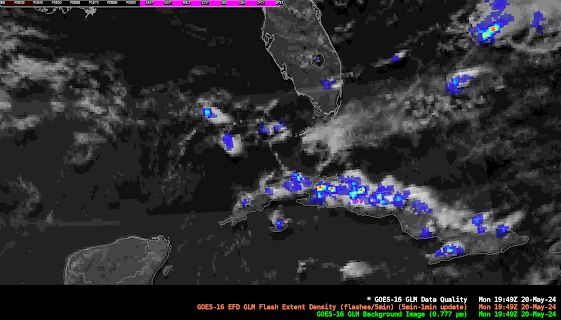Quick initial thoughts on the mesoscale environment with limited data to analyze. Satellite shows residual PBL stability present with billow clouds immediately ahead of the convection that has developed, likely tied to residual capping EML. However, surface heating is resulting in steep low level lapse rates below this although midlevel lapse rates are poor at the moment, they should steepen and large scale ascent should begin to help lift/erode the cap soon. As we crest the peak of diurnal surface diabatic heating and enter early evening, the low-level jet should increase, just conceptually given upstream mid-latitude system over the central Rockies. I’m guessing (without model data) that as the trough approaches the hodographs should elongate in both the low and mid levels, resulting in greater shear values and more organized convective cells soon.

-dryadiabat
We noticed that there is a lot of “noise” in the velocity data from PAR. I think Charles mentioned this is due to a different dealiasing scheme relative to what we’re used to in the 88D. We don’t notice the noise in KTLX. This is impacting TORP, with values as high as 37% indicated on the back side of the storms associated with this signal, that clearly is false. Analysis of PAR and 88D data and conceptual models from storm structure give us confidence these probabilities are far too high and there’s no immediate tornado threat.

-dryadiabat

Quick note to say in the early stages of storm development, AzShear and DivShear seem noisy and not adding a lot of value without more clear mesocyclones and storm-scale velocity features. I’m sure that will change as the case evolves.
-dryadiabat
Continued jumping around of TORP objects chasing the bad data quality velocity due to the dealiasing strategy (re: post above). Meanwhile, we’re monitoring trends in intensity and character of the midlevel mesocyclones which are more steady using base data analysis to understand storm organization and as an indication of tornado protential trends.
-dryadiabat
I’m not sure I could’ve identified storm top divergence with DivShear along if just looking at that product without looking at velocity. In velocity it’s fairly clear although only a small area of outbounds, whereas in DivShear is more noisy. With time, I’m sure I could learn to pick this signature out more easily in DivShear, but for now it seems relatively difficult for me.
Also, another limitation is sometimes the (-) and (+) components are separated by one elevation, and not on the same scan, so it may not be as apparent using DivShear as compared to just standard base velocity.

 -dryadiabat
-dryadiabat
Highest TORP probs of the day so far in northern Grady County seem to be associated with a storm that has anticyclonic rotation. But this may be more associated with noisy velocity data since TORP isn’t set to detect anticyclonic rotation, if I understand correctly. Unsure what to make of this. Top image is PAR, bottom image is KTLX (slightly higher tilt). 

-dryadiabat
Really liking the temporal resolution of PAR, especially trying to analyze/assess the northern Grady County supercell which displayed some weak low-level rotation embedded within the front flank of the cell to its south. Evolution on rotation magnitude and width were more easily seen in PAR than KTLX, even with SAILS3 enabled.
This has made the Prob trend graphics more complete and useful too (see below):

-dryadiabat
TORP probs increased from 38% to 63% as the tornado report came in and about the time the Tornado Warning decision was made. It peaked at 79% when Vrot was strongest, but as Vrot decreased TORP values fell quickly, despite likely tornado still ongoing given character of the velocity couplet. Probs dropped completely and the TORP object disappeared at 0007z despite weak couplet still present. Tornado threat seemed to completely end shortly after, but perhaps persisted a minute or two longer after TORP dropped.

-dryadiabat
Unsure if it’s just the color tables or other factors but the AzShear seems more useful in PAR than in the WSR-88D.

-dryadiabat
Noisy velocity not associated with tornadic rotation has 38% prob.

-dryadiabat
The “one more scan” dilemma is easier with the rapid updates of PAR. Rather than waiting for a new full volume of data, or even another SAILS cut, we have quicker updates to see the evolution of the RFD.

-dryadiabat
Noticed 87% TORP but there is some bad velocity quality within the TORP circle separate from the weak couplet that I’m wondering if may be contributing to these probabilities, since the couplet is fairly weak. It is tight though so that may be the primary impetus for the higher probabilities.

-dryadiabat
Also noticed higher (+) velocity on the north side of the circulation in KTLX compared to PAR. KTLX at the top, and PAR at the bottom below.


-dryadiabat
Stronger couplet and better AzShear and DivShear signal noted simultaneously. 
-dryadiabat
~30 knot Vrot in central McClain County on KTLX. Stronger inbound maxima noticed on PAR too. Probs on TORP seem to be holding in mid-range a little more than I would’ve expected. 55% peak so far.


-dryadiabat












 -dryadiabat
-dryadiabat










 -dryadiabat
-dryadiabat







 -dryadiabat
-dryadiabat














